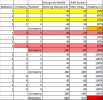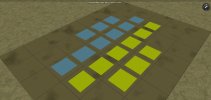I am considering starting up a Western Front campaign for FGM sometime this year. Are there FGM players who would get into it?
Currently I am running an Eastern Front campaign and I'm developing a modern one as well (probably ready for launch around June this year).
These are priorities and I won't abandon them, but I feel capable of getting another one rolling, if there is interest.
Checking the Battlefront website, I only just realised there are extra expansions available for both CMBN and CMFI that I don't have, such as CMBN Commonwealth and CMFI Rome.
I am prepared to invest in these modules. However, the easiest solution may be CMFB.
Here is an overview of each game. Which one to use?
The biggest challenge of creating and running a campaign is the availability of decent battle maps that are approximately 1km x 1km (or larger - can be cut down).
Are there any FGM players who can tell us which Combat Mission game has the most maps available this size, both stock and player-made included?
Combat Mission Battle for Normandy
The base game covers the three month period following the Allied D-Day landings, from Operation Overlord in June through the Cobra Breakout in August. American and German Heer.
Commonwealth Forces
British, Canadian, Polish Allied, Waffen SS and Luftwaffe Field Division.
Market Garden
Allied forces include the full range of American, British, and Polish Airborne forces, plus British ground forces that lead the relief effort.
On the German side are ad-hoc units quickly thrown together from Heer, Waffen SS, Luftwaffe base personnel, and Naval staff units.
Combat Mission Fortress Italy
Starts with the Sicilian campaign from July through August 1943.
American, Italian, and German forces. Italian Bersaglieri, American Rangers, and the German Herman Göring Division.
Gustav Line
The Italian mainland, revolving around Salerno, Anzio, and Monte Cassino, and culminating in the capture of Rome on June 4, 1944.
All German and American forces are updated to reflect formational and equipment changes since the Sicilian campaign.
Brand new formations and equipment cover the elite Fallschirmjäger and the combat formations of the United Kingdom, Canada, Poland, and New Zealand.
Rome to Victory
Continue to fight your way through Italy from June 1944 in Rome to the Italian Alps
New TO&E that includes Indian, Brazilian, South African and Free French forces. Also added are Waffen SS and Luftwaffe Herman Goering units and new vehicles and combat formations for existing nationalities.
Combat Mission Final Blitzkrieg
Covers regions depicting the Ardennes (Belgium), France, Germany, and Holland from October 1944 through the end of January 1945.
United States Army, German Heer, Waffen-SS, and Fallschirmjäger.
I would be interested! Although currently not much room for more games. But it takes a while to get started I might have more time / space












































































